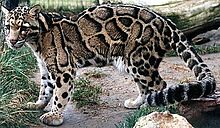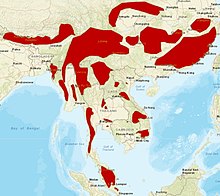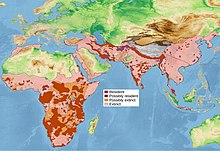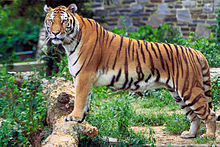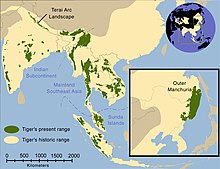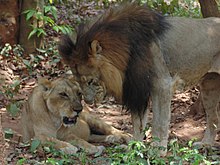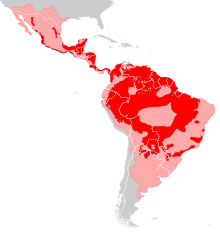Pantherinae
| Pantherinae[1] Temporal range:
| |
|---|---|
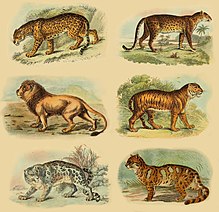
| |
| Pantherinae subfamily members (from left): jaguar, leopard, lion, tiger, snow leopard and clouded leopard | |
| Scientific classification | |
| Domain: | Eukaryota |
| Kingdom: | Animalia |
| Phylum: | Chordata |
| Class: | Mammalia |
| Order: | Carnivora |
| Suborder: | Feliformia |
| Family: | Felidae |
| Subfamily: | Pantherinae Pocock, 1917 |
| Genera | |
Pantherinae is a subfamily within the family Felidae which was named and first described by Reginald Innes Pocock in 1917.[2] The Pantherinae and the Felinae diverged from a common ancestor 11.5 to 10.8 million years ago.[3][4]
Characteristics
The members of the Pantherinae have an imperfectly ossified suspensorium of the hyoid apparatus. It is connected to the base of the base skull by an elastic tendon, which provides mobility to the larynx.[2] They have a single, rounded, vocal fold with a thick mucosal lining, a large vocalis muscle, and a large cricothyroid muscle, with long and narrow membranes. The vocal fold is longer than 9 mm (0.35 in). This structure of the larynx enables them to roar,[5] with the exception of the Neofelis genera[6] and the snow leopard.[7]
Their rhinarium is flat, and, at most, only barely reaches the dorsal side of the nose. The area between the nostrils is narrow, and not extended sidewards, as in the Felinae.[8]
Classification
Pocock originally defined the Pantherinae as comprising the genera Panthera and Uncia.[2] Today, Uncia has been subsumed to Panthera; and the Pantherinae also includes the genus Neofelis.[9]
Living genera
The following table shows the extant taxa within the Pantherinae, grouped according to the traditional phenotypical classification.[9] Estimated genetic divergence times of the genotypical pantherine lineage are indicated in million years ago (mya), based on analysis of autosomal, xDNA, yDNA and mtDNA gene segments;[3] and estimates based on analysis of biparental nuclear genomes.[4]
| Genus | Species | IUCN Red List status and distribution |
|---|---|---|
| Neofelis Gray, 1867[10] 14.45 to 8.38 mya |
Clouded leopard (N. nebulosa) (Griffith, 1821)[11] | VU[12] |
| Sunda clouded leopard (N. diardi) (Cuvier, 1823)[13]
diverged 2 to 0.9 mya[14] |
VU[15] | |
| Panthera Oken, 1816[16] 11.75 to 0.97 mya[4] |
Leopard (P. pardus) (Linnaeus, 1758)[17] | VU[18] |
| Tiger (P. tigris) (Linnaeus, 1758)[19] | EN[20] | |
| Snow leopard (P. uncia) (Schreber, 1775)[21] | VU[22] | |
| Lion (P. leo) (Linnaeus, 1758)[23] | VU[24] | |
| Jaguar (P. onca) (Linnaeus, 1758)[25] | NT[26] |
Evolution
The Felidae originated in Central Asia in the Late Miocene, with the Pantherinae diverging about 11.5 to 10.8 million years ago.[3][4] Several fossil Panthera species were described:
- Panthera blytheae is the oldest known species that possibly lived about 5.95 to 4.1 million years ago.[27]
- Panthera palaeosinensis lived in the early Pleistocene around two to three million years ago in northern East Asia.[28]
- Panthera zdanskyi is dated to 2.55 to 2.16 million years ago.[28]
- Panthera gombaszoegensis lived from about 2 to 0.35 million years ago in Europe.[29]
- Panthera youngi lived in the Pleistocene about 0.69 to 0.42 million years ago in China.[30]
- Panthera spelaea lived in Europe after the third Cromerian interglacial stage from about 450,000 to 14,000 years ago.[31]
- Panthera atrox lived in North America during the Pleistocene and early Holocene about 340,000 to 11,000 years ago.[32]
- Panthera shawi was a lion-like cat in South Africa that possibly lived in the early Pleistocene.[33]
- Panthera balamoides lived in the Yucatan Peninsula in Mexico, during the Pleistocene.[34]
There is evidence of distinct markers for the mitochondrial genome for Felidae.[35][36]
Results of a DNA-based study indicate that the tiger (Panthera tigris) branched off first, followed by the jaguar (P. onca), the lion (P. leo), then the leopard (P. pardus) and snow leopard (P. uncia).[37]
Felis pamiri, formerly referred to as Metailurus, is now considered a probable relative of extant Pantherinae.[38]
See also
References
- ^ Wozencraft, W. C. (2005). "Pantherinae". In Wilson, D. E.; Reeder, D. M. (eds.). Mammal Species of the World: A Taxonomic and Geographic Reference (3rd ed.). Johns Hopkins University Press. pp. 545–548. ISBN 978-0-8018-8221-0. OCLC 62265494.
- ^ a b c Pocock, R. I. (1917). "The Classification of existing Felidae". The Annals and Magazine of Natural History. Series 8. XX: 329–350. doi:10.1080/00222931709487018.
- ^ a b c Johnson, W. E.; Eizirik, E.; Pecon-Slattery, J.; Murphy, W. J.; Antunes, A.; Teeling, E. & O'Brien, S. J. (2006). "The late Miocene radiation of modern Felidae: a genetic assessment". Science. 311 (5757): 73–77. Bibcode:2006Sci...311...73J. doi:10.1126/science.1122277. PMID 16400146. S2CID 41672825.
- ^ a b c d Li, G.; Davis, B. W.; Eizirik, E. & Murphy, W. J. (2016). "Phylogenomic evidence for ancient hybridization in the genomes of living cats (Felidae)". Genome Research. 26 (1): 1–11. doi:10.1101/gr.186668.114. PMC 4691742. PMID 26518481.
- ^ Hast, M. H. (1989). "The larynx of roaring and non-roaring cats". Journal of Anatomy. 163: 117–121. PMC 1256521. PMID 2606766.
- ^ Guggisberg, C.A.W. (1975). "Clouded leopard Neofelis nebulosa (Griffiths, 1821)". Wild cats of the World. New York: Taplinger Publishing. pp. 125–130. ISBN 0-8008-8324-1.
- ^ Weissengruber, G. E.; Forstenpointner, G.; Peters, G.; Kübber-Heiss, A.; Fitch, W. T. (2002). "Hyoid apparatus and pharynx in the lion (Panthera leo), jaguar (Panthera onca), tiger (Panthera tigris), cheetah (Acinonyx jubatus) and domestic cat (Felis silvestris f. catus)". Journal of Anatomy. 201 (3): 195–209. doi:10.1046/j.1469-7580.2002.00088.x. PMC 1570911. PMID 12363272.
- ^ Hemmer, H. (1966). "Untersuchungen zur Stammesgeschichte der Pantherkatzen (Pantherinae). Teil I" [Researching the phylogenetic history of the Pantherinae. Part I]. Veröffentlichungen der Zoologischen Staatssammlung München. 11: 1–121.
- ^ a b Kitchener, A. C.; Breitenmoser-Würsten, C.; Eizirik, E.; Gentry, A.; Werdelin, L.; Wilting, A.; Yamaguchi, N.; Abramov, A. V.; Christiansen, P.; Driscoll, C.; Duckworth, J. W.; Johnson, W.; Luo, S.-J.; Meijaard, E.; O’Donoghue, P.; Sanderson, J.; Seymour, K.; Bruford, M.; Groves, C.; Hoffmann, M.; Nowell, K.; Timmons, Z.; Tobe, S. (2017). "A revised taxonomy of the Felidae: The final report of the Cat Classification Task Force of the IUCN Cat Specialist Group" (PDF). Cat News (Special Issue 11): 64−75.
- ^ Gray, J. E. (1867). "Notes on the skulls of the Cats. 5. Neofelis". Proceedings of the Scientific Meetings of the Zoological Society of London. 1867: 265–266.
- ^ Griffith, E. (1821). "Felis nebulosa". General and particular descriptions of the vertebrated animals arranged comfortably to the modern discoveries and improvements in zoology. London: Baldwin, Cradock & Joy. p. 37.
- ^ Grassman, L.; Lynam, A.; Mohamad, S.; Duckworth, J. W.; Borah, J.; Willcox, D.; Ghimirey, Y.; Reza, A. & Rahman, H. (2016). "Neofelis nebulosa". IUCN Red List of Threatened Species. 2016: e.T14519A97215090.
- ^ Cuvier, G. (1823). "Recherches sur les ossemens fossiles; ou, l'on retablit les caracteres de plusiers animaux dont les revolutions du globe ont detruit les especes". Les Ruminans et les Carnassiers Fossiles, Volume IV. Paris: G. Dufour & E. d'Ocagne.
- ^ Buckley-Beason, V. A.; Johnson, W. E.; Nash, W. G.; Stanyon, R.; Menninger, J. C.; Driscoll, C. A.; Howard, J.; Bush, M.; Page, J. E.; Roelke, M. E.; Stone, G.; Martelli, P.; Wen, C.; Ling, L.; Duraisingam, R. K.; Lam, V. P. & O'Brien, S. J. (2006). "Molecular Evidence for Species-Level Distinctions in Clouded Leopards". Current Biology. 16 (23): 2371–2376. doi:10.1016/j.cub.2006.08.066. PMC 5618441. PMID 17141620.
- ^ Hearn, A.; Ross, J.; Brodie, J.; Cheyne, S.; Haidir, I. A.; Loken, B.; Mathai, J.; Wilting, A. & McCarthy, J. (2016). "Neofelis diardi". IUCN Red List of Threatened Species. 2016: e.T136603A97212874.
- ^ Oken, L. (1816). "1. Art, Panthera". Lehrbuch der Zoologie. 2. Abtheilung. Jena: August Schmid & Comp. p. 1052.
- ^ Linnaeus, C. (1758). "Felis pardus". Caroli Linnæi Systema naturæ per regna tria naturæ, secundum classes, ordines, genera, species, cum characteribus, differentiis, synonymis, locis. Vol. Tomus I (decima, reformata ed.). Holmiae: Laurentius Salvius. p. 41−42.
- ^ Stein, A. B.; Athreya, V.; Gerngross, P.; Balme, G.; Henschel, P.; Karanth, U.; Miquelle, D.; Rostro, S.; Kamler, J. F. & Laguardia, A. (2016). "Panthera pardus". IUCN Red List of Threatened Species. 2016: e.T15954A102421779.
- ^ Linnaeus, C. (1758). "Felis tigris". Caroli Linnæi Systema naturæ per regna tria naturæ, secundum classes, ordines, genera, species, cum characteribus, differentiis, synonymis, locis. Vol. Tomus I (decima, reformata ed.). Holmiae: Laurentius Salvius. p. 41.
- ^ Goodrich, J.; Lynam, A.; Miquelle, D.; Wibisono, H.; Kawanishi, K.; Pattanavibool, A.; Htun, S.; Tempa, T.; Karki, J.; Jhala, Y. & Karanth, U. (2015). "Panthera tigris". IUCN Red List of Threatened Species. 2015: e.T15955A50659951.
- ^ Schreber, J. C. D. (1777). "Die Unze". Die Säugethiere in Abbildungen nach der Natur mit Beschreibungen. Erlangen: Wolfgang Walther. pp. 386–387.
- ^ McCarthy, T.; Mallon, D.; Jackson, R.; Zahler, P. & McCarthy, K. (2017). "Panthera uncia". IUCN Red List of Threatened Species. 2017: e.T22732A50664030.
- ^ Linnaeus, C. (1758). "Felis leo". Caroli Linnæi Systema naturæ per regna tria naturæ, secundum classes, ordines, genera, species, cum characteribus, differentiis, synonymis, locis. Vol. Tomus I (decima, reformata ed.). Holmiae: Laurentius Salvius. p. 41.
- ^ Bauer, H.; Packer, C.; Funston, P. F.; Henschel, P. & Nowell, K. (2016). "Panthera leo". IUCN Red List of Threatened Species. 2016. doi:10.2305/IUCN.UK.2016-3.RLTS.T15951A107265605.en.
- ^ Linnaeus, C. (1758). "Felis onca". Caroli Linnæi Systema naturæ per regna tria naturæ, secundum classes, ordines, genera, species, cum characteribus, differentiis, synonymis, locis. Vol. Tomus I (decima, reformata ed.). Holmiae: Laurentius Salvius. p. 42. (in Latin)
- ^ Quigley, H.; Foster, R.; Petracca, L.; Payan, E.; Salom, R. & Harmsen, B. (2017). "Panthera onca". IUCN Red List of Threatened Species. 2017: e.T15953A123791436.
- ^ Tseng, Z.J.; Wang, X.; Slater, G.J.; Takeuchi, G.T.; Li, Q.; Liu, J. & Xie, G. (2014). "Himalayan fossils of the oldest known pantherine establish ancient origin of big cats". Proceedings of the Royal Society B: Biological Sciences. 281 (1774): 20132686. doi:10.1098/rspb.2013.2686. PMC 3843846. PMID 24225466.
- ^ a b Mazák, J. H.; Christiansen, P.; Kitchener, A. C. (2011). "Oldest Known Pantherine Skull and Evolution of the Tiger". PLOS ONE. 6 (10): e25483. Bibcode:2011PLoSO...625483M. doi:10.1371/journal.pone.0025483. PMC 3189913. PMID 22016768.
- ^ Marciszak, A. (2014). "Presence of Panthera gombaszoegensis (Kretzoi, 1938) in the late Middle Pleistocene of Biśnik Cave, Poland, with an overview of Eurasian jaguar size variability". Quaternary International. 326–327: 105–113. Bibcode:2014QuInt.326..105M. doi:10.1016/j.quaint.2013.12.029.
- ^ Sotnikova, M.V. & Foronova, I.V. (2014). "First Asian record of Panthera (Leo) fossilis (Mammalia, Carnivora, Felidae) in the Early Pleistocene of Western Siberia, Russia". Integrative Zoology. 9 (4): 517–530. doi:10.1111/1749-4877.12082. PMID 24382145.
- ^ Burger, J.; Rosendahl, W.; Loreille, O.; Hemmer, H.; Eriksson, T.; Götherström, A.; Hiller, J.; Collins, M. J.; Wess, T. & Alt, K. W. (2004). "Molecular phylogeny of the extinct cave lion Panthera leo spelaea". Molecular Phylogenetics and Evolution. 30 (3): 841–849. doi:10.1016/j.ympev.2003.07.020. PMID 15012963.
- ^ Christiansen, P. & Harris, J. M. (2009). "Craniomandibular morphology and phylogenetic affinities of Panthera atrox: implications for the evolution and paleobiology of the lion lineage". Journal of Vertebrate Paleontology. 29 (3): 934–945. doi:10.1671/039.029.0314.
- ^ Sabol, M. (2011). "Masters of the lost world: a hypothetical look at the temporal and spatial distribution of lion-like felids". Quaternaire. Hors-série. 4: 229–236.
- ^ Stinnesbeck, Sarah R.; Stinnesbeck, Wolfgang; Frey, Eberhard; Avilés Olguín, Jerónimo; Rojas Sandoval, Carmen; Velázquez Morlet, Adriana; González, Arturo H. (2019). "Panthera balamoides and other Pleistocene felids from the submerged caves of Tulum, Quintana Roo, Mexico". Historical Biology: An International Journal of Paleobiology. 32 (7): 930–939. doi:10.1080/08912963.2018.1556649. S2CID 92328512.
- ^ Wei, L.; Wu, X.; Jiang, Z. (2008). "The complete mitochondrial genome structure of snow leopard Panthera uncia". Molecular Biology Reports. 36 (5): 871–878. doi:10.1007/s11033-008-9257-9. PMID 18431688. S2CID 22736941.
- ^ Yu, L.; Qing-wei, L.; Ryder, O.A.; Ya-ping, Z. (2004). "Phylogenetic relationships within mammalian order Carnivora indicated by sequences of two nuclear DNA genes" (PDF). Molecular Phylogenetics and Evolution. 33 (3): 694–705. doi:10.1016/j.ympev.2004.08.001. PMID 15522797. Archived from the original (PDF) on 2011-07-07.
- ^ Yu, L.; Zhang, Y. P. (2005). "Phylogenetic studies of pantherine cats (Felidae) based on multiple genes, with novel application of nuclear beta fibrinogen intron 7 to carnivores". Molecular Phylogenetics and Evolution. 35 (2): 483–495. doi:10.1016/j.ympev.2005.01.017. PMID 15804417.
- ^ Geraads, D.; Peigné, S. (2016). "Re-Appraisal of Felis pamiri Ozansoy, 1959 (Carnivora, Felidae) from the Upper Miocene of Turkey: the Earliest Pantherine Cat?". Journal of Mammalian Evolution. 24 (4): 415–425. doi:10.1007/s10914-016-9349-6. S2CID 207195894.
External links
- Choi, C. Q. (2011). "World's Oldest Tiger Species Discovered". Live Science. Retrieved 2019-06-30.

